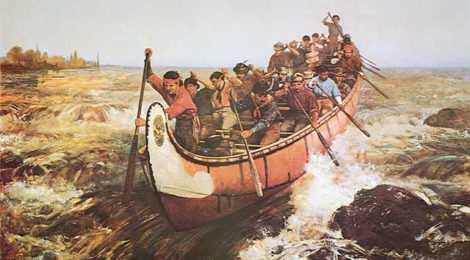
Birch Bark Canoe and the Rabaska
Usage and History:
The birch bark canoe and it’s larger cousin the trade canoe, were vital to the transit of people and goods throughout the North American continent which was mostly covered with dense forests in the east but crisscrossed by vast networks of rivers and lakes. These waterways formed the basic navigational network for both the Native peoples and later the colonists. The rivers could be treacherous and obstacles such as rapids, marshes and overground relays called portages needed to be crossed. As such, the craft needed to be resilient to impacts and scrapes from rocks and tree trunks in rapids, have a draft shallow enough to pass through marshes and be light enough for a few men to carry over hills and through forested terrain. To this end the birch bark canoe was the pinnacle of naval design in North America, from long before Europeans arrived until the industrial revolution and trains started to replace the Voyageur. The versatility of the canoe is often understated, these crafts could be tied together to form catamarans sturdy enough for the Great Lakes, and makeshift sails could be used to cross large bodies of water when the wind would cooperate.
Other names for large trade canoes include Rabaska, from the Algonquin and Cree word Athapaskaw which also lends its name to the Athabasca river and lake, meaning “reeds here and there” which was used by Voyageur, as well as Canot du Maitre. These embarkations could reach 11 m in length and 1.5 m in width, and carry 60 bundles of fur, a crew of 8 men and their provisions for weeks, the canoe alone weighed around 150 kg (330 lbs). In sporting events these canoes are typically manned by a crew of 12 with 1 coxswain navigating, which also reflects the typical contingent of a war party.
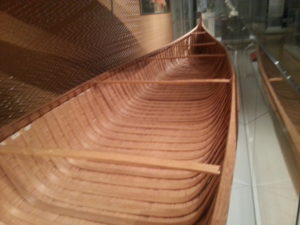
Inside of a Rabaska
Very few surviving canoes remain due to the nature of their construction, and only two Rabaskas from the 19th century remain, one of which is part of the Native American exhibit of the ROM. Modern archaeologist have been building birch bark canoes in an effort to preserve this knowledge for posterity as part of the Native culture’s patrimony.
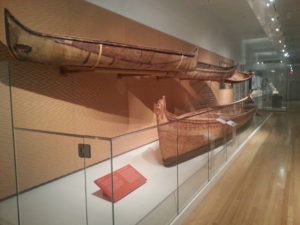
Birch Bark Canoes from ROM Exhibit
Materials:
- Birch bark
- Cedar logs
- Spruce roots
- Iron wood nails
- Pine tar
Manufacturing:
The primary material which composes the canoe is of course birch bark, which is collected from felled birch trees, since removing the entirety of the bark exposes the tree to insects and diseases which is akin to a death sentence. With a sharp knife the bark can be cut in sizable patches and then peeled off by hand. To make a canoe the larger the peel of bark the better it is, though butting two or three patches along the keel of the ship [link to come] was a common practice. Since the diameter of birch trees tends to be relatively small, extra patches of bark will be needed on either side of the canoe to extend its waterboard height. These patches are all sown together using spruce root cordage.
Spruce roots were a valuable resources to North American First Nations, they provided a flexible material which could be used to sew together not only birch bark but used as cordage in the construction of wigwams, long houses and palisades. To optimize the material usage the roots are split down the middle by making a starting cut at one end and tearing the halves apart by hand which in addition to doubling the length of cordage creates a rope with a flat side. The flat side is ideal in securing via friction as it provides a much larger contact surface. Soaking the cordage in hot water makes it easier to manipulate and split.
A bottom frame is made out of bent cedar planks and laid upon the cleaned birch bark, these framing pieces will give the canoe it’s shape. To bend the bark, boiling water is poured on the bark along the edge of the frame. The hot water loosens the fibrous bark and allows it to be bent upwards. By putting pegs on the outside of the frame and weighing down the inside of the canoe, this bend will be forced to stay. It may be necessary to cut lines perpendicular to the bend to relieve stress in the bark.
Similarly thin long planks of cedar are bent and will become the gunwale of the canoe. These planks are laid atop the bent bark, from there the maker can measure out the additional height necessary to be added in bark to either side. This bark is then overlapped and stitched using double sided stitching [link to come] with the spruce root cordage. The gaps created by the cuts, patches and sewing will later be tarred to seal the outer skin of the canoe. Once the bark reaches the desired height, the inner and outer gunwale frames are clamped on either side of the bark, and the excess bark is trimmed away. By having the gunwale in two parts it locks the bark into place, to secure the assembly, spruce roots are used to lash the to gunwale parts to the bark. At a set distance the lashings are passed twice through every hole that was awled into the bark, tightly wrapping it around each pass. The inner gunwale has a 45 degree bevel cut along the downward edge facing the bark. This notch will allow cedar ribs to be locked into place later on.
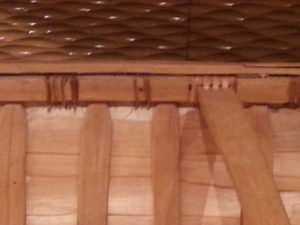
Root Lashings and Ribs
The head plates at either end of the canoe are made by splitting a long plank of cedar repeatedly down the middle until this plank acquires great flexibility. Again by soaking the cedar in boiling water, this flexibility can yet again be increased. This piece of wood is then bent into the sinuous shape of the head plates and tied with long weeds. Larger planks of cedar are also split to cover the voids in the ends of the embarkation.
The head plates are then stitched into the ends of the canoe with a double stitch pattern leading to the traditional x shapes lash crossings at the front and back ends. The awl is used to pierce through the split cedar plank serving as the head piece frame. Once this is accomplished the exterior shape of the canoe is now finalised. Wide cedar planks are then split and laid length wise in the canoe, these will serve to spread the load to the entire shell of the canoe. Ribs, again from cedar planks are boiled and bent to shape. These ribs are then tenoned to match the 45 degree bevel of the inner gunwale piece. The ribs are inserted into the canoe at an angle and hammered into place starting from either end to meet in the centre. The central ribs are the hardest to fit seeing as the adjoining ribs need to be moved out of place to allow it to fit inside.
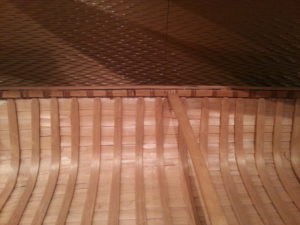
Central Ribs in a Rabaska
Another piece of cedar is used as a top cover to the gunwale and nailed into place using iron wood nails. These nails are pegged at a slight angle from the horizontal alternating direction along the length, this is done to increase the tension between the upper and lower gunwale components, which prevent them from pulling apart.
The canoe is now completed, and only needs to be sealed, but before doing this operation the wood and bark need to dry out so that the pine pitch can adhere properly to the surfaces and prevent warping as the canoe dries. Once dry, the seems and stitch lines are then sealed using a mixture of pine pitch and charcoal which reduces the brittleness of the pitch and gives the traditional black look to the sealing lines. Once this mixture has hardened appropriately, the canoe will need to be put into the water for a few weeks so that the wood fibres can swell making the craft watertight.
Featured Photo Credit: Shooting the Rapids By Anne Hopkins – wiki commons
References
http://www.native-art-in-canada.com/birchbarkcanoes.html
http://www.northwestjournal.ca/VIII4.htm
http://jumaka.com/birchbarkcanoe/buildingpage/building.htm
http://www.barkcanoe.com/tips.htm
